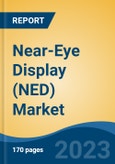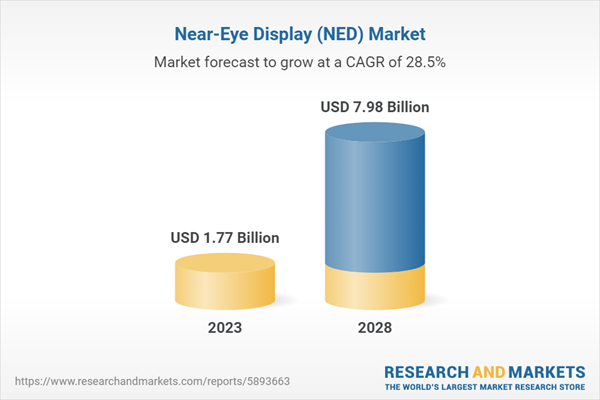Speak directly to the analyst to clarify any post sales queries you may have.
10% Free customizationThis report comes with 10% free customization, enabling you to add data that meets your specific business needs.
A near-eye display, sometimes referred to as a head-mounted display, has played a crucial role in delivering virtual images to people. In the "cross/extended reality" (XR) spectrum, near-eye displays immerses the user in a virtual environment (VR) or enhances the actual world (AR) by superimposing digital information. Additionally, near-eye displays react to head movement and enable manipulation and object interaction. Aside from that, newly popular near-eye displays have the potential to create cutting-edge experiences that might alter a variety of markets, including manufacturing, healthcare, communication, and entertainment. For the final iteration of the commercial near eye display an ultra-wide field of vision (FOV), clear depth cues, and a small form factor with tolerable weight are needed. Although using freeform surface components to produce not just a wide field of vision but a better and lighter image may be a beneficial strategy, their weight and volume make them unwearable. The system may be extended to include reflecting mirrors, a wedge-shaped freeform prism in place of the spherical lens category, or gradient index lenses.
The popularity of VR and AR technologies is rising, notably in gaming-related goods and events, because of the developing and expanding gaming culture among millennials and members of generation Z. To improve the experience for spectators and players, some gaming tournaments use goods utilising near-eye display technology. The increased use of VR and AR technologies in the entertainment sector to produce various forms of content will hasten the demand for and expansion of the near-eye display market over the next several years.
Increasing Investment by Technology Giants to Boost the Adoption of Near-Eye Display (NED) Products
The current surge of digital innovation and digitalization has increased the demand for Near-Eye Display (NED) which has caused businesses to reevaluate their product specifications. Near-Eye Display (NED) is becoming increasingly popular among organizations that are eager to embrace digital transformation. Manufacturers worldwide are looking for solutions and measures to optimize their operations and improve efficiency. Technology giants are focusing their efforts on collaborating and forming partnerships with companies that create and provide value for their customers. Innovative near-eye display modules that offer effective and efficient performance are being developed by Meta, Apple, Microsoft Corporation, and the Samsung Group. For instance, on Feb 2022, Porotech, a leader in microdisplay technology, obtained a USD 20 million investment to hasten its worldwide expansion and increase mass manufacturing of its distinctive micro-LED products. The commercialization of XR glasses and the most recent wave of user interface innovation will be sped up by this investment. Additionally, several research organizations are looking into the use of AR technology for a range of products and applications. Along with this, a surge in the number of near-year display items on the market may be attributed to manufacturers and firms increased R&D efforts. Therefore, increasing investment by technology giants to boost the adoption of near-eye display (NED) products is expected to grow the global Near-Eye Display (NED) market in the forecast period.Increasing use of OLED Microdisplays in latest applications
Emerging technologies in OLEDs are promising new applications with the potential to revitalize microdisplay. OLEDoS microdisplays are gaining momentum due to advanced features such as higher contrast, faster response time, lighter weight, and a wider operating temperature range than any other LCDs. With better color quality, and increased viewing angles, the near-eye application’s OLEDoS micro-displays offer a potential solution to all the issues that have kept near-eye systems from taking a major role in the display marketplace. In addition, OLEDoS microdisplays have the potential for creating new opportunities for ultraportable digital appliances and entertainment products. Therefore, many enterprises are integrating OLEDoS and LEDoS technologies in their products as these technologies have fast response time and thin & light manufacturing capacity. With the proliferation of digitalization, the growth in the adoption of smart devices and microdisplay based devices have increased from the past years. For instance, according to the report by The Elec, large enterprise such as Samsung and South Korea's LG Display Co Ltd. are developing new OLED etching technology for Apple Inc. The company will use the technology in mixed-reality headsets. Furthermore, the growing cooperative efforts to develop high-quality display and integrating with the automotive industries are proliferating the adoption of OLED Microdisplays in latest applications. On May 24, 2023, Kopin's partner partnerships extend their deposition capabilities to improve and expand its OLED deposition capabilities, strengthening their supply chain and ensuring continuity of sovereign supply to several US Department of Defense and NATO-friendly locations. The supply chain's duplication and redundancy reduce the likelihood of interruptions and provide its defence clients with peace of mind. Therefore, various enterprises are adopting the OLED microdisplays into applications such as imaging, projection, smart wearable etc. to optimize the product efficiency.Rising Demand for AR/VR Devices Propelling Growth
Augmented reality (AR) and virtual reality (VR) are developing as next-generation display platforms for deeper human-digital interactions as a result of the quick advancements in high-speed transmission and processing. These technologies have attracted significant attention, owing to their potential application in next-generation smart devices providing a gateway to countless AR applications that are improving daily lives. Emerging technologies like holography and lithography have reshaped the AR/VR display systems. Most VR and AR devices are head-mounted or eye-glass-type wearable devices. In these devices, displays are important for enhancing immersion, because most humans are more receptive to information in the visual modality, compared with other modalities such as auditory, tactile, olfactory, and gustatory. As the technology is still in the initial stage, enterprises are enormously trying to integrate with their businesses enabling an advance offering for better customer experience. For instance, BOE Technology Group Co., Ltd. unveiled a Virtual Reality Glasses, Pancake Particle/BOE Pancake Optic 250g All-In-One VR Headset. The all-in-one VR headset of the future weighs only 250g and is 1/4 as thick as a conventional VR headset. On 28 Feb 2023, Xiaomi corporation announced the launch of lightweight AR glasses, which have built-in color microOLED screens, gesture control, and a VR mode switch for total immersion. Moreover, VR headsets require small, lightweight near eye displays since they are necessary for a comfortable user experience, therefore the demand for the near eye display is growing. Thus, rising demand for AR/VR devices are propelling the growth of the near eye display (NED) market in the forecasting period.Growing use of Head Mounted Display in Aerospace & Defence
Head Mounted Display (HMD) technology is revolutionizing the way information is displayed by providing pilots with all the crucial information they require on the helmet's visor. These technologies significantly improve reaction times and lighten the burden, which dramatically improves the capacity to carry out their objectives. With the growing adoption of head mounted displays in the aviation industries, pilots can easily see the information such as text, image, altitude, etc. which is projected through the display while enhancing the operational capabilities. It provides its user with significant situational awareness (SA) by projecting real-time, critical flight and mission information overlaid onto their view of the outside world. According to a study by the Israeli Research Institute, operational capacities of fighter planes armed with HMDs have increased by three times. For instance, the US Army has incorporated the latest advances in electronic systems including global positioning system (GPS), radio, and a near-eye or Helmet-Mounted Display (HMD) into the Warfighter’s body-worn equipment to provide real-time situation awareness. With the modernization of head mounted displays, many enterprises are integrating this near eye display technology as a primary solution for most of the advanced avionics systems. Fighter aircraft such as the F-35, with the use of modern HMDS aids in enabling pilots to look in any direction. This helmet is so sophisticated and impressive that F-35 pilots fly with only two displays, one in their cockpit, the other on their helmet. Therefore, the growing use of head mounted display in aerospace & defense is attributed to the growth of near eye display (NED) in the global market.Market Segmentation
The Global Near Eye Display (NED) market is segmented into component, device type, technology, end-user, and region. Based on component, the market is segmented into image generators, optical combiners, and imaging optics. Based on device type, the market is further divided into augmented reality (AR), virtual reality (VR), others further bifurcated into EVF and mixed reality (MR). Based on technology, the market is divided into TFT LCD (thin film transistor liquid-crystal display), OLEDoS (organic light-emitting diode on silicon), LCos (liquid crystal on silicon), Micro-LED (light-emitting diodes), AMOLED (active-matrix organic light-emitting diodes), DLP (digital light processing), and laser beam scanning. Based on end user, the market is segmented into automotive, aerospace & defense, consumer, healthcare, and others.Company Profiles
Sony Group Corporation, Himax Technologies, Inc., Kopin Corporation, eMagin Corporation, MICROOLED Technologies, BOE Technology Group Co., Ltd., Syndiant, Inc., JBD Xianyao Display Technology, TriLite Technologies GmbH, Texas Instruments Incorporated are among the major players that are driving the growth of the Global Near-Eye Display (NED) Market.Report Scope:
In this report, the global Near-Eye Display (NED) market has been segmented into the following categories, in addition to the industry trends which have also been detailed below:Near-Eye Display (NED) Market, By Component:
- Image Generator
- Optical Combiners
- Imaging Optics
Near-Eye Display (NED) Market, By Device Type:
- Augmented Reality (AR)
- Virtual Reality (VR)
- Others (EVF and Mixed Reality (MR))
Near-Eye Display (NED) Market, By Technology:
- TFT LCD
- OLEDs
- LCOs
- Micro-LED
- AMOLED
- DLP
- Laser Beam Scanning
Near-Eye Display (NED) Market, By End User:
- Automotive
- Aerospace & Defense
- Consumer
- Healthcare
- Others
Near-Eye Display (NED) Market, By Region:
- Asia-Pacific
- China
- Japan
- India
- Australia
- South Korea
- North America
- United States
- Canada
- Mexico
- Europe
- United Kingdom
- Germany
- France
- Spain
- Italy
- Middle East & Africa
- Israel
- Qatar
- Saudi Arabia
- UAE
- South America
- Brazil
- Argentina
- Colombia
Competitive Landscape
Company Profiles: Detailed analysis of the major companies present in the Global Near-Eye Display (NED) Market.Available Customizations:
With the given market data, the publisher offers customizations according to a company’s specific needs.This product will be delivered within 1-3 business days.
Table of Contents
Companies Mentioned
- Sony Group Corporation
- BOE Technology Group Co., Ltd.
- TriLite Technologies GmbH
- Himax Technologies, Inc.
- Texas Instruments Incorporated
- MICROOLED Technologies
- Kopin Corporation
- eMagin Corporation
- JBD Xianyao Display Technology
- Syndiant, Inc.
Table Information
| Report Attribute | Details |
|---|---|
| No. of Pages | 170 |
| Published | October 2023 |
| Forecast Period | 2023 - 2028 |
| Estimated Market Value ( USD | $ 1.77 Billion |
| Forecasted Market Value ( USD | $ 7.98 Billion |
| Compound Annual Growth Rate | 28.5% |
| Regions Covered | Global |
| No. of Companies Mentioned | 10 |









